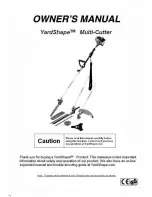
107
Espectrofotômetro
NANOCOLOR
®
Advance 1.1, 11.2021
en
NANOCOLOR
®
COD 160
www.mn‑net.com
www.mn‑net.com
DE Tel.: +49 24 21 969-0 [email protected]
CH Tel.: +41 62 388 55 00 [email protected]
FR Tel.: +33 388 68 22 68 [email protected]
US Tel.: +1 484 821 0984 [email protected]
MACHEREY-NAGEL GmbH & Co. KG
Neumann-Neander-Str. 6–8
52355 Düren · Germany
www.mn‑net.com
www.mn‑net.com
DE Tel.: +49 24 21 969-0 [email protected]
CH Tel.: +41 62 388 55 00 [email protected]
FR Tel.: +33 388 68 22 68 [email protected]
US Tel.: +1 484 821 0984 [email protected]
MACHEREY-NAGEL GmbH & Co. KG
Neumann-Neander-Str. 6–8
52355 Düren · Deutschland
REF: 985026
Overview
The test is suitable for the photometric determination of the chemi-
cal oxygen demand (COD). The test is in accordance with DIN ISO
15705–H45 and is equivalent to EPA Standard Method 5220 D.
This test is suitable for water, wastewater and sludge.
• Measuring range: 15–160 mg/L O
2
(method 0261)
• Number of tests: 20
• Wavelength for photometric determination: 436 / 450 nm
• Shelf life: 12 months
• Reaction time: 120 minutes
• Storage temperature: 15–25 °C
• Storage conditions: protected from sunlight, upright.
Method
The organic compounds of a sample are oxidized by heating the
sample in a mixture of sulphuric acid and potassium dichromate.
The chemical oxygen demand (COD) of a water sample is the con-
centration of oxygen that is equivalent to the amount of potassium
dichromate consumed. The change in the potassium dichromate
concentration is determined via the change in absorbance after
digestion.
Interferences
The foreign materials shown here do not interfere with the test up
to the indicated concentrations (in mg/L). The cumulative effect of
different interfering ions has not been tested.
Data in mg/L:
• Cl
-
: 1500
Important: For samples in which the chloride content is high, shake
the tube to suspend the precipitate prior to adding the sample. If
the chloride content is greater than 1500 mg/L, you must dilute
the sample or use a chloride masking agent (REF 918911). Once it
has reacted in the heating block, the solution must not be cloudy;
turbidity can result in high COD values.
The use of precipitated mercury sulphate will allow the turbidity to
settle.
This method is not suitable for analyzing seawater.
Turbidity leads to lower measured values.
Reagents and accessories
Contents of reagents set:
• 20 test tubes R0
Required devices:
• MACHEREY-NAGEL photometer
• MACHEREY-NAGEL heating block
• Digital piston pipette 1–5 mL (REF 916909) with pipette tips
(REF 916916)
• Safety bottle for shaking COD tubes (REF 91637)
Standards
•
NANOCONTROL
COD 160 (REF 92526)
•
NANOCONTROL
Multistandard Sewage outflow 1 (REF 925011)
Sampling and preparation
See DIN EN ISO 5667-3-A 21 and DIN 38409–H41-1.
Quality control
The measurement of a blank value and a standard is recommended
before every measuring series as quality control measure.
Quality data:
The following data were determined during production according to
ISO 8466-1 and DIN 38402-A51:
• Number of LOTs: 75
• Standard deviation of the method: ± 1.06 mg/L O
2
• Coefficient of variation of the process: ± 1.28 %
• Confidence interval: ± 2.44 mg/L O
2
Specified data for procedure:
• Sensitivity (absorbance of 0.010 A corresponds to): 2.18 mg/L
O
2
• Accuracy of a measurement value: ± 8.40 mg/L O
2
LOT-specific certificates are available at
www.mn‑net.com
.
Procedure
1. Open round cell and hold slightly tilted
2. Pipette 2 mL of sample into test tube
3. Seal test tube and shake vigorously (use safety bottle, cuvette
will become hot!).
4. Heat for 2 h at 148 °C or for 30 min at 160 °C
5. Take the tube from the heating block
6. Shake again after 10 min. while still warm
7. Cool to room temperature
8. Clean outside of test tube
9. Measure
Notes
Test a sample of COD-free water (REF 918993) to generate a blank
value for the reagent.
When using a standard, the measured value is constant over a
period of min. 30 min.
Correction value e. g. for colored or turbid samples possible (see
photometer manual).
When using other photometers, make sure measurements are
possible in test tubes (16 mm OD) and calibrate the method.
Information regarding safety can be found on the box' label
and in the safety data sheet. You can download the SDS from
www.mn‑net.com/SDS
.
10/2020
Fig. 6: Instrução do kit
Realize o teste de acordo com as instruções
do respectivo kit (Fig. 6). Leia com atenção
para obter resultados precisos e confiá‑
veis. Prepare a amostra de acordo com as
instruções.
AVISO
Limpe as cubetas com um pano sem fiapos antes da inserção desta no suporte
de cubeta, afim de remover quaisquer impurezas e/ou umidade da cubeta,
evitando sujar o suporte de cubetas e lentes.
Step 5: Executar uma medição
AVISO
As cubetas contaminadas podem contaminar o suporte de cubeta e levar a
resultados de medição incorretos.
Fig. 7: Medição de teste em tubo
Testes em tubo: insira o tubo com o código
de barras no suporte de cubetas. O código de
barras é reconhecido e lido automaticamente
(Fig. 7). Para kits de teste sem medição do
zero, o resultado é exibido automaticamente
após alguns segundos.
Ao usar um teste com medição do zero, o
dispositivo primeiramente vai solicitar que
você meça a solução zero. A medição do
zero é disparada pressionando
. Então a
amostra é inserida e é medida pressionando
.
Alternativamente, o método desejado pode ser acessado selecionando a partir das listas
no menu
Testes MN
ou inserindo o número do teste no menu correspondente.
AVISO
A primeira vez que um método é chamado, ele é automaticamente iniciado no
submétodo 1. O submétodo (forma química) pode ser alterado clicando na
entrada “Submétodo” na tela de resultados.
















































